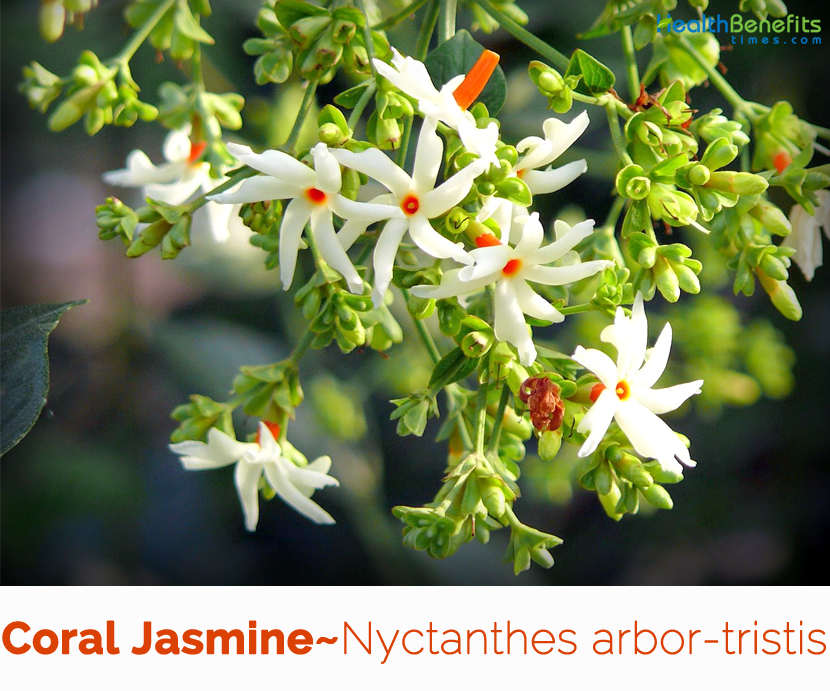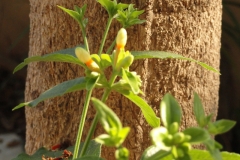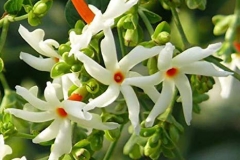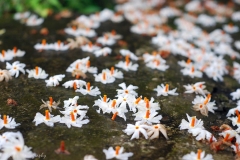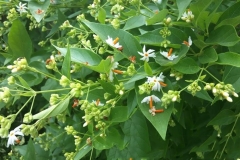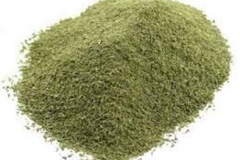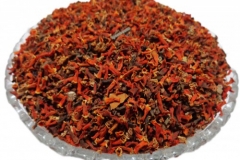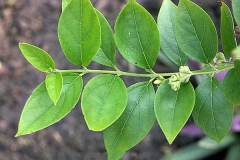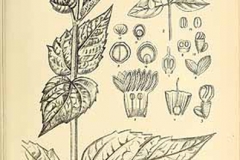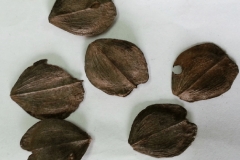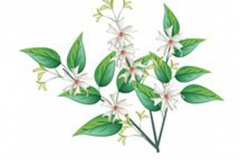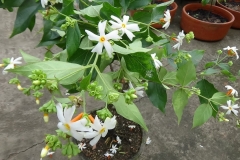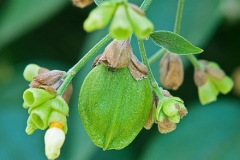| Coral Jasmine Quick Facts | |
|---|---|
| Name: | Coral Jasmine |
| Scientific Name: | Nyctanthes arbor-tristis |
| Origin | South Asia and Southeast Asia |
| Colors | Green when young turning to Brown as they matures |
| Shapes | Flat heart-shaped to round capsule 2 cm (0.79 in) diameter, with two sections each containing a single seed |
| Taste | Bitter |
| Health benefits | Intestinal worms, Beneficial for cough and cold, Alleviates piles, Good for hair, Treat anxiety, restlessness, Heals wounds, Beneficial for skin, Treat high blood pressure (hypertension), Stomach problems, Antidote to snake bites,Treat malaria and other nauseous fevers |
| Part used | Pharmacological Effect |
| Bark | Anti-Microbial |
| Flower Oil | Perfume |
| Flowers | Ant-Bilious
Anti-filarial Anti-Inflammatory Antioxidant Diuretic Dyspepsia Ophthalmic Sedative |
| Leaves | Anthelmintic
Antibacterial Antifungal Anti-Inflammatory Antioxidant Anti-Pyretic Arthritis Asthma Bronchitis Cholecystagogue Constipation Cough Dyspepsia Flatulence Heartburn Hepato-protective Immuno-potential Nausea Reptile Venom Rheumatism Ringworm Sciatica |
| Seeds | Antibacterial
Antifungal Alopecia Anti-leishmanial Hair Tonic Immuno-modulatory Piles |
| Stem | Antioxidant
Antipyretic Bronchitis Snakebite |
Health benefits of Coral Jasmine
Every part of Nyctanthes arbortristis is used for medicinal purpose due to health promoting properties. Seeds are used in treatment of piles. Decoction of flowers and leaf is used in treatment of gout. Leaves juice is given in case of dry cough. Paste of leaves is used externally in treatment of skin related troubles specifically in treatment of ring worm. Listed below are few of the popular health benefits of using coral jasmine
1. Treat malaria and other nauseous fevers
Leaves of the Coral Jasmine flower are often used to treat malarial fever. It can be used as a natural remedy for fevers that cause nausea, diarrhea and rising body temperature caused due to bile maladies. Leaf extracts are mostly effective against both types of malaria, even the resilient strains of Plasmodium falciparum, which is why they are also used to get rid of malaria parasites in Maharashtra and Gujarat.
Although a fever could be considered any body temperature above the normal 98.6 F (37 C), medically, a person is not considered to have a significant fever until the temperature is above 100.4 F (38.0 C). Reason behind treating a fever is to increase comfort. The juice of its leaves is bitter and saline in taste and provides effective relief in the treatment of several types of inflammation and fever.
2. Antidote to snake bites
The most important thing to do for a snake bite is to get emergency medical help as soon as possible. A doctor will evaluate the victim to decide on a specific course of treatment. In some cases, a bite from a venomous snake is not life-threatening. Severity depends on the location of the bite and the age and health of the victim. If the bite is not serious, the doctor may simply clean the wound and give the victim a tetanus vaccine.
If the situation is life-threatening, the doctor may administer anti-venom. This is a substance created with snake venom to counter the snake bite symptoms. It’s injected into the victim. The sooner the anti-venom is used, the more effective it will be. In cases of snake poisoning, the juice of the leaf is administered.
3. Stomach problems
Symptoms of Irritable bowel syndrome (IBS) include stomach cramps, bloating, diarrhea and constipation. The pain is often relieved when you go to the toilet. Other stomach-related problems are stomach ulcer, heartburn, and acid reflux, or inflammation of the stomach lining (gastritis). The juice of its leaves, when mixed with a little sugar, is a good medicine for treatment of stomach ailments of children. Night Jasmine is very useful in treating constipation in children, it prevents acidity and dyspepsia. Flowers are bitter astringent and are useful for ophthalmic, stomachic and carminative, gastritis, hepatitis, diarrhea, vertigo, and dysmenorrhea.
4. Treat high blood pressure (hypertension)
High blood pressure (hypertension) is defined as high pressure (tension) in the arteries, which are the vessels that carry blood from the heart to the rest of the body. The diastolic pressure is the pressure in the arteries as the heart relaxes. Normal blood pressure is below 120/80; blood pressure between 120/80 and 139/89 is called “pre-hypertension,” and a blood pressure of 140/90 or above is hypertension. Coral Jasmine can be used to treat high blood pressure if needed.
High blood pressure increases the risk of heart disease and stroke. High blood pressure is medically referred to as hypertension. Keys to the treatment of high blood pressure are exercise, weight management, and a healthy diet. In fact, exercising, Yoga makes blood pressure medications more effective. See your doctor before starting a new fitness program.
5. Beneficial for skin
Your skin separates the inside of your body from the outside world. It protects you from bacteria and viruses and regulates your body temperature.
Conditions that irritate, clog, or inflame your skin can cause symptoms like redness, swelling, burning, and itching. Allergies, irritants, your makeup, and certain diseases and immune system problems can cause dermatitis, hives, and other skin conditions. Many skin problems, such as acne, also affect your appearance. Your skin can also develop several kinds of cancers.
Coral Jasmine leaves are blended into a paste and are used in skin related troubles. The fresh leaves are boiled in mustard oil and used externally for treating ringworm.
6. Heals wounds
Wound is a type of injury which happens relatively quickly in which skin is torn, cut, or punctured (an open wound), or where blunt force trauma causes a contusion (a closed wound). In pathology, it specifically refers to a sharp injury which damages the dermis of the skin. Coral Jasmine helps to heal the wound. Use dry leaves’ powder with water every morning and evening to get relief.
7. Treat anxiety, restlessness
Night Jasmine is also used to treat anxiety, restlessness, and headaches and also to treat anxiety and vertigo.
8. Good for hair
Coral Jasmine is good for hair and it is easily available. It is useful in treating baldness, scurvy, and affections of the scalp. It helps to cure lice, dandruff, and get rid of grey hair. The paste of the seeds is applied over the area affected with alopecia; we get result soon after using it continuously.
9. Alleviates piles (Hemorrhoids)
Hemorrhoids, commonly known as piles, are swollen blood vessels in or around the anus and rectum. Haemorrhoidal veins are located in the lowest part of the rectum and the anus. Sometimes they swell so that the vein walls become stretched, thin, and irritated by passing bowel movements. Hemorrhoids are classified into two general categories – internal and external.
It hurts very badly. In many cases, people who had gone through the operation, complain the pain after the operation also. Coral Jasmine seeds are very useful for people who suffered from piles. The seeds are crushed and the aqueous paste is applied externally on the piles. It helps to alleviates piles.
10. Beneficial for cough and cold
Sneezing, sore throat, a stuffy nose, coughing everyone knows the symptoms of the common cold. It is probably the most common illness. Coral Jasmine herbs are used for treating congestion that is caused by asthma, dry cough, bronchitis etc. In cases of asthma and cough, the powder of dried leaf or bark of Nyctanthes arbor- tristis is given with betel leaf juice in a dose of 2-3 g.
11. Intestinal worms
Worms in gastrointestinal tract is a condition where the gut is infected by parasites. A number of different worms are counted as intestinal parasites, including roundworms, flatworms and hookworms. This infection is generally marked by intestinal discomfort, diarrhea and in occasional cases anemia. Doctors attribute infected food, poor hygiene and sanitation as the primary causes of these problems. Coral Jasmine is one of the most common Ayurvedic remedies for intestinal worms. In the absence of clinical studies it is best to refer to an Ayurveda doctor to know the potential anti-helminthic effects of this herb on humans.
12. Different face packs
You can easily treat your skin at home with the best homemade face packs to reveal you’re true complexion and to enjoy a glowing flawless skin. Here we have collected a bunch of the best homemade face packs for the skin. You can use the flower of Night Jasmine. As it achieves a gaudy shine to the face and gives guaranteed remedy to a variety of skin ailments.
Traditional uses and benefits of Coral Jasmine
- Extracts of the seeds, flowers and leaves possesses immune-stimulant, hepato-protective, anti-leishmanial, antiviral and anti-fungal activities in vitro.
- Leaves have been used in Ayurvedic medicine and Homeopathy for sciatica, arthritis, fevers, and as a laxative.
- Leaves are antibacterial and are used for the treatment of fungal infection, cough, and snakebite.
- Juice of its leaves is bitter and saline in taste and provides effective relief in the treatment of several types of inflammation and fever including malaria, intermittent fever, common cough and cold.
- It provides a certain remedy for various body disorders ranging from common cough and cold to arthritis and sciatica.
- Juice of its leaves when mixed with a little sugar is good medicine for treatment of stomach ailments of children.
- Boil 1 teaspoon of the leaves of Coral Jasmine in a glass of water over a gentle fire. Drink this decoction as needed to overcome sciatica.
- Apply on the swellings the flower paste prepared by grinding a handful of the flowers with some water to cure edema.
- Mix 1 teaspoons of the juice extracted from the leaves with 1 teaspoon of good honey and take the mixture with some warm water. Use it till the fever subsides.
- To take care of chest and throat congestion, cough and the accumulation of phlegm, dry some bark collected from the plant, dry some bark collected from the plant, powder and store. Take a few pinches of this bark powder with a piece of Areca Nut and betel leaf. Use only as an herbal medicine. Avoid consuming this mixture as soon as the conditions listed above are under control.
- Apply the powdered seeds on the scalp. Leave for an hour and wash with soap nut fruits to cure dandruff and other scalp conditions.
- Mix one teaspoon of the juice extracted from the leaves with one teaspoon of honey and a pinch of common salt and use it till the worms are passed out of the system.
- Paste made by crushing the leaves is beneficial in curing fever, diabetes and high blood pressure.
- Leaf juice combined with honey cures Cough and Fever.
- Leaf decoction cures the problems like sciatica, arthritis and malaria.
- Flowers prevent the formation of Gas in the stomach.
- Flowers prevent the secretion of excessive bile from the liver and aid in the digestion.
- Stem bark powder is useful in treating Rheumatic pain.
- It is an effective cure for graying of hair, dandruff, baldness, lice and scalp Infections.
- It cures brain disorders like Vertigo and Anxiety.
- It alleviates dental problem like scurvy.
- Night Jasmine is a good herbal remedy for congestion due to phlegm, bronchitis, dry cough and asthma.
- It is encouraging for hypertension i.e. high blood pressure.
- It is helpful in maintaining sugar level in the blood.
- Night Jasmine is a good herbal remedy for Skin complaints namely Ringworm, Pruritus i.e. itching and Fungal Infections.
- It curbs digestion problems namely dyspepsia and acidity.
- It keeps a check on Liver ailments like Malaria, Hepatitis and Jaundice.
- It helps in treatment of helminthiasis i.e. Worm Invasion.
- It counteracts Urinary complaints like strangury.
- It eases the condition of Dysmenorrhea i.e. Menstrual Cramps.
- Night Jasmine eases constipation.
- It halts loose stools as a result of diarrhea.
- It is an antidote for reptile i.e. Snake bites.
- Leaf juice is mixed with common salt to treat intestinal worms.
- Seeds are crushed and the aqueous paste is applied externally on the piles.
- Patients with gynecological problems are advised to take 3 fresh night jasmine leaves, with 5 black peppers.
- Decoction of its seeds is used for washing hair daily to get rid of dandruff and lice.
- Paste of the seed is applied over the area affected with alopecia.
- Powder of dried leaf or bark is given with betel leaf juice to treat asthma and cough.
- Cold infusion of the leaf is given to treat difficulty in micturition.
- In Orissa, stem bark of Parijata is boiled with dry ginger power and pippali or long pepper. This is taken orally for two days to cure malaria.
Ayurvedic Health benefits of Coral Jasmine
- Slip disc: Take about a kilogram of Night Jasmine, Stem, leaves and all. Wash them. Place them in a pan. Pour at least 3 three liters of water. Bring it to boil. Lower heat. Simmer for half an hour. Cool. Store. Drink one cup, twice a day. The morning cup should be on an empty stomach. Expect recovery within 15 days.
- Antidote: Rub the crushed leaves of Night Jasmine over bitten areas.
- Inflammation: Squeeze the juice of fresh leaves of Night Jasmine. Drink 2 teaspoons twice a day.
- Sciatica: Take 3 medium sized fresh leaves. Boil them in a glass of water on a low flame. Have it daily to cope up with the problem.
- Fever: Grind some fresh leaves of Night Jasmine to make a paste. Add half teaspoon Honey and eat.
- Cough: Extract out the juice of Night Jasmine leaves. Add one tsp honey. Take it thrice a day.
- Scurvy: Crush seeds of Night jasmine to make a powder. Add some water in it to make a paste. Apply it over infected gums.
- Ringworm: Make a paste of fresh night jasmine leaves. Apply it on the affected part. Note: Do it till the problem persists.
- Arthritis: Crush 6 to 7 Night jasmine leaves and boil in a glass of water. Boil until the water remains half. Leave it overnight. Next morning, strain, stir and drink on an empty stomach. Drink daily for a month.
- Dengue: Macerate some leaves of Night Jasmine. Grind some Black Pepper. Boil it in 3 Glasses of Water. Boil till water becomes half. Cool and store. Administer one sip every half hour, for the next 12 Hours. Platelets count will start to rise almost immediately.
- Expectorant: Combination of Night Jasmine and Areca Nut is an effective formula to expel the phlegm. Take a small piece of each Night Jasmine stem bark and Areca Nut. Now place them on Night Jasmine leaf. Wrap and chew.
- Malaria: Take 2 grams of each Night Jasmine stem bark, Long Pepper and Ginger. Boil them in a glass of water on a low flame. Have it for 2 to 3 days.
- Dengue and Chikungunya a trio: Buy tincture of Night Jasmine, Tinospora Cordifolia and Yarrow from a Homeopathic shop. Give 10 drops of Night Jasmine (in some water) to start the treatment. After three hours give ten drops of Yarrow. After three hours give 10 drops of Tinospora Cordifolia. Keep repeating for the next three days. The fever should become normal within one day. However, the drop in fever must not be considered as a cure. The remedies should be continued for at least 3 days.
- Malaria fever: Extract juice of 7-8 leaves of Coral Jasmine, mix with ginger juice and honey. Take twice a day, in the morning and evening,
- Chronic fever: Extract juice of 7 – 8 soft tender leaves of Coral Jasmine. Take 5-10 ml of this juice with ginger juice and honey in the morning and evening helps in the old fever.
- Joint pain after Chikungunya: Drinking decoction of Coral Jasmine leaves for 10-15 days is very useful.
- Enlargement of Liver: Giving juice of 7-8 Coral Jasmine leaves with ginger juice and honey twice a day helps in this condition.
- Hair fall (baldness disease): Grinding the seed of Coral Jasmine with water and applying of the scalp can help.
- Hemorrhoids: Soak 2 grams of flowers in Coral Jasmine in 30 ml water at night. In the morning, rub the flowers in water and mix 1 teaspoon of sugar and drink empty stomach. Do it regularly for 1 week.
Other facts
- Flowers can be used as a source of yellow dye for clothing.
- Flower is the official flower of the state of West Bengal, India, and for Kanchanaburi Province, Thailand.
- Scented flowers bloom at night and drop before rising of the sun.
- Flowers are used prepare perfumes and scents after distillation.
- Leaves shed in February or March and renewed in June-July.
- In Hindu mythology Parijata is regarded as one of the five wish-granting trees of Devaloka.
Precautions
- It can reduce the blood sugar level in diabetic patient. So monitor the sugar level.
- Leaf intake may cause nausea and vomiting due to its bitter taste.
- Do not chew the leaf.
- Person who grounded the dried leaves developed vesicles on both palms.
References:
https://davesgarden.com/guides/pf/go/95610/
http://www.theplantlist.org/tpl1.1/record/kew-354899
https://en.wikipedia.org/wiki/Nyctanthes_arbor-tristis
http://www.florajournal.com/archives/2016/vol4issue4/PartA/4-5-2-720.pdf
https://biomedres.us/pdfs/BJSTR.MS.ID.001199.pdf


